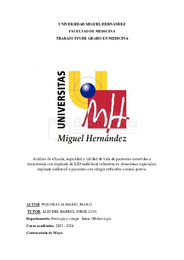Resumen :
Objetivo: Evaluar los resultados visuales en pacientes sometidos a lensectomía con implante de LIO multifocal refractiva (LIO LENTIS Mplus [Oculentis GmbH]) en situaciones especiales: catarata unilateral o cirugía refractiva corneal previa.
Material y métodos: Un total de 101 pacientes (126 ojos) fueron estudiados en tres grupos independientes: catarata unilateral, previo myopic LASIK y hyperopic LASIK. Se evaluaron en los grupos los resultados visuales preoperatorios y en el sexto mes posoperatorio mediante la agudeza visual lejana sin corrección (UDVA), agudeza visual cercana sin corrección (UNVA), agudeza visual lejana corregida (CDVA) y agudeza visual cercana corregida (CNVA) en logMAR. Se analizó la existencia de diferencias estadísticamente significativas entre el pretratamiento y el postratamiento mediante la prueba de los rangos con signo de Wilcoxon, al no cumplir la muestra criterios de normalidad en la prueba de Kolmogorov-Smirnov. La significancia de todos los test de hipótesis se fijó a 0.05.
Resultados: En el grupo de catarata unilateral se consiguió una mejora estadísticamente significativa (p<0,05) en la UDVA, con un valor de 0,76+0,8 (logMAR) para la preoperatoria y de 0,08+0,12 en la postoperatoria; también la CDVA mostró diferencias significativas con valores de 0,36+0,69 en el preoperatorio y de 0,02+0,04 en el posoperatorio (p<0,05); así como la AV cercana con y sin corrección también mostraron diferencias significativas. En el grupo con previo hyperopic LASIK la mejora estadísticamente significativa (p<0,05) se obtuvo en la UDVA con un valor preoperatorio de 0,39+0,33 y postoperatorio de 0,10+0,11; también en la UNVA. En el grupo con previo myopic LASIK se consiguieron diferencias significativas para la UDVA, pues la media preoperatoria fue de 0,77 y la postoperatoria de 0,10 (p<0,05); también en la CDVA: 0,39 en el preoperatorio y 0,02 en el postoperatorio (p<0,05).
Conclusión: El implante de una LIO MF refractiva rotacionalmente asimétrica (LIO LENTIS Mplus) tras cirugía de cataratas en pacientes en situaciones especiales: cirugía refractiva corneal previa (hyperopic LASIK o myopic LASIK) o implante unilateral en pacientes con catarata unilateral, es eficaz y segura, demostrando una buena calidad de visión tras la cirugía.
Purpose: Visual outcomes evaluation in patients undergoing Multifocal Refractive IOL implantation (LENTIS Mplus IOL [Oculentis GmbH]) in special situations: unilateral cataract or prior corneal refractive surgery.
Methods: A total of 101 patients (126 eyes) were studied in three independent groups: unilateral cataract, prior myopic LASIK, and hyperopic LASIK. Preoperative and sixth-month postoperative visual outcomes were evaluated in the groups using uncorrected distance visual acuity (UDVA), uncorrected near visual acuity (UNVA), corrected distance visual acuity (CDVA), and corrected near visual acuity (CNVA) in logMAR. The existence of statistically significant differences between pre-treatment and post-treatment was analyzed using the Wilcoxon signed-rank test, as the sample did not meet normality criteria in the Kolmogorov-Smirnov test. The significance level for all hypothesis tests was set at 0.05.
Results: In the unilateral cataract group, statistically significant improvement (p<0.05) was achieved in UDVA, with values of 0.76±0.8 (logMAR) preoperatively and 0.08±0.12 postoperatively; CDVA also showed significant differences with values of 0.36±0.69 preoperatively and 0.02±0.04 postoperatively (p<0.05); similarly, both uncorrected and corrected near visual acuity showed significant differences. In the prior hyperopic LASIK group, statistically significant improvement (p<0.05) was observed in UDVA with preoperative value of 0.39±0.33 and postoperative value of 0.10±0.11; as well as in UNVA. In the prior myopic LASIK group, significant differences were achieved for UDVA, with preoperative mean of 0.77 and postoperative mean of 0.10 (p<0.05); also in CDVA: 0.39 preoperatively and 0.02 postoperatively (p<0.05).
Conclusion: The implantation of a rotationally asymmetric refractive multifocal IOL (LENTIS Mplus IOL) after cataract surgery in patients in special situations: previous corneal refractive surgery (hyperopic LASIK or myopic LASIK) or unilateral implantation in patients with unilateral cataract, is effective and safe, demonstrating good quality of vision after surgery.
|
 La licencia se describe como: Atribución-NonComercial-NoDerivada 4.0 Internacional.
La licencia se describe como: Atribución-NonComercial-NoDerivada 4.0 Internacional.
.png)
